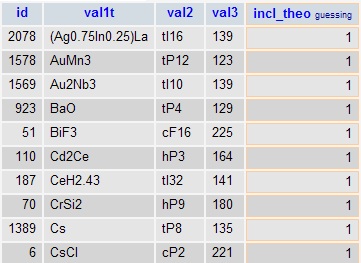Quotes of the day
January 14, 2008 Posted by Emre S. Tasci
The Fourteen Bravais Lattices
When one relaxes the restriction to point operations and considers the full symmetry group of the Bravais lattice, there turn out to be fourteen distinct space groups that a Bravais lattice can have. Thus, from the point of view of symmetry, there are fourteen different kinds of Bravais lattice. This enumeration was first done by M.L. Frankenheim (1842). Frankenheim miscounted, however, reporting fifteen possibilities. A. Bravais (1845) was the first to count the categories correctly.
(…)
The seven crystal systems and fourteen Bravais lattices described above exhaust the possibilities. This is far from obvious (or the lattices would have been known as Frankenheim lattices).
Ashcroft, Mermin Solid State Physics Saunders 1976 Ch. 7
I don’t understand why you materials scientists are so busy in working out experimentally the constitution [crystal structure and phase diagram] of multinary systems. We know the structure of the atoms [needing only Atomic Numbers], we have the laws of quantum mechanics, and we have electronic calculation machines, which can solve the pertinent equation rather quickly!
J.C. Slater, 1956 as quoted by Villars et al. Journal of Alloys and Compounds 279 (1998) 1
Protected: mP12, oP12, tP6
Posted by Emre S. Tasci
Less is More MySQL
January 9, 2008 Posted by Emre S. Tasci
(-Right now, I’m going to define a new category: the MySQL category!-)
Suppose that, you have a database which contains a huge number of entries about the materials (like, for instance, the Pauling Database). Let it have 163 different properties we can query about. It is optimized for queries, so, the values are enumerated and the labels for these are kept in "pauling.dblxxx" tables, which may be something like this for the "Chemical System" property:
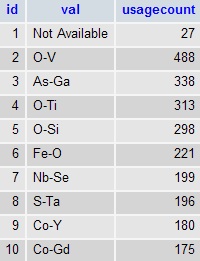
The values are kept in "pauling.valxxx" tables:
.jpg)
(Where the first one is the EntryCode, the PRIMARY key that relates all the tables and the second value is the enumeration for the value. For example, 1422 for the 13. property is actually Ho-Ir 🙂
![]()
and there is one more set of tables, the paulingv2.valxxx tables which are stored and keyed in val order, so:
- if we want to find the EntryCodes corresponding to a given property, we query the paulingv2.valxxx tables
- if we want to find the property that is corresponding to a given EntryCode we query the pauling.valxxx tables
- if we want to "translate" the property’s enumeration, we query the pauling.dblxxx tables.
Here is the thing: Let’s say that we want the Structure Types that have an Atomic Enviroment Type (AET) of a rhombic dodecahedron , with a/b ratio 1, alpha=beta=90o. The property numbers for these are:
Structure Type : 32
AET : 86
a/b ratio : 44
alpha : 41
beta : 42
Since the last three properties are numeric, we don’t enumerate them and the enumeration corresponding to the rhombic dodecahedron for AET is 6. So, fasten your seat belts, we are about to lift off! :
SELECT id,pauling.dbl032.val FROM pauling.dbl032
INNER JOIN
(
SELECT DISTINCT val FROM val032
INNER JOIN
(
SELECT v AS EntryCode FROM
(
(
SELECT val001.val AS v FROM val001
INNER JOIN paulingv2.val086
USING (EntryCode)
WHERE paulingv2.val086.val=6
) AS A
INNER JOIN
(
(
SELECT val001.val AS v FROM val001
INNER JOIN paulingv2.val044
USING (EntryCode)
WHERE paulingv2.val044.val=1
) AS B
INNER JOIN
(
# 41=90 && 42= 90
(
SELECT val001.val AS v FROM val001
INNER JOIN paulingv2.val041
USING (EntryCode)
WHERE paulingv2.val041.val=90
) AS C
INNER JOIN
(
SELECT val001.val AS v FROM val001
INNER JOIN paulingv2.val042
USING (EntryCode)
WHERE paulingv2.val042.val=90
) AS D
USING (v)
)
USING (v)
)
USING (v)
)
) AS G
USING (EntryCode)
)
AS Q ON (id = Q.val) ORDER BY val;
Later addition: Assuming 86=6; we don’t really need the other constraints 44=1, 42=90, 41=90 – do we?… So it’s just the boring:
SELECT id FROM pauling.dbl032
INNER JOIN
(
SELECT DISTINCT val FROM val032
INNER JOIN
(
SELECT v AS EntryCode FROM
(
(
SELECT val001.val AS v FROM val001
INNER JOIN paulingv2.val086
USING (EntryCode)
WHERE paulingv2.val086.val=6
) AS A
)
) AS G
USING (EntryCode)
)
AS Q ON (id = Q.val) ORDER BY Q.val;
The result of this is something like this:
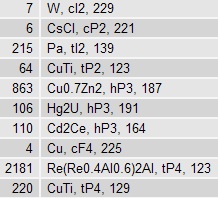
To be honest, it is actually something like this :
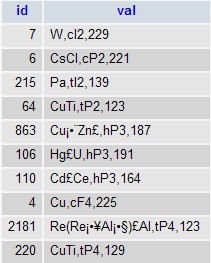
The strange symbols are the price we pay for using non-standard charsets! 😉
So, to tidy up, I import this to a table with the following structure:
CREATE TABLE IF NOT EXISTS `bcc` (
`id` smallint(5) unsigned NOT NULL default ‘0’,
`val` varchar(254) NOT NULL default ”,
`usagecount` smallint(5) unsigned NOT NULL default ‘0’,
`val1` varchar(30) NOT NULL default ‘0’,
`val2` varchar(6) default NULL,
`val3` varchar(3) default NULL,
`val1t` varchar(30) NOT NULL,
`val2sp` smallint(5) unsigned NOT NULL,
`SG` tinyint(3) unsigned NOT NULL,
PRIMARY KEY (`id`),
KEY `val` (`val`),
KEY `val1` (`val1`)
) ENGINE=MyISAM DEFAULT CHARSET=utf8;
You have already met the id and val columns. "usagecount" will be imported from the pauling.dbl013 table; val1, val2, val3 are the seperated structure type information (ie, for "CuTi,tp4,129", val1="CuTi", val2="tp4" and val3="129"); val1t is the "translated" version of val1 which is the readeable one (ie, "(Ag¡•¦§Zn¡•¥¥)©Zn" is translated as "(Ag0.56Zn0.44)8Zn"). The translation is done via the following simpe php function:
function translate_symbols($string,$f_tr2symb=true)
{
$symbol_array = array("•","¡","¢","£","¤","¥","¦","§","¨","©","ª");//subscript values
$transl_array = array(".","0","1","2","3","4","5","6","7","8","9");//subscript values
if(!$f_tr2symb)return str_replace($transl_array,$symbol_array,$string);
else return str_replace($symbol_array,$transl_array,$string);
}
"val2sp" is the sliced numeric value from the Pearson Symbol stored in the val2 column.
To tidy up:
$query = "SELECT id, val1, val2 FROM bcc";
$qresult = mysql_query($query);
while($result = mysql_fetch_array($qresult))
{
$query2 = "UPDATE bcc SET val1t=\"".translate_symbols($result["val1"])."\", val2sp=SUBSTRING(val2,3,20) WHERE id = ".$result["id"]." LIMIT 1";
//echo $query2."\n";
$q2result = mysql_query($query2);
echo mysql_error();
}
You can refer to my previous entry for slicing up the "val" column. I had already done this while constructing the pauling.dblxxx tables, so in fact the actual view of the pauling.dbl032 table is the following one
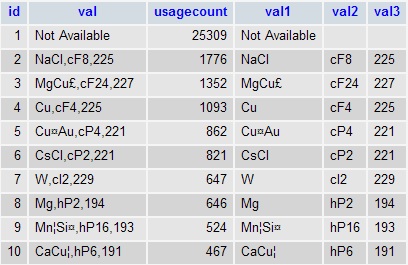
meaning, I can just import them using the id’s of my new table:
UPDATE bcc, pauling.dbl032 SET
bcc.val = pauling.dbl032.val,
bcc.usagecount = pauling.dbl032.usagecount,
bcc.val1 = pauling.dbl032.val1,
bcc.val2 = pauling.dbl032.val2,
bcc.val3 = pauling.dbl032.val3
WHERE bcc.id = pauling.dbl032.id
Now we have something like:
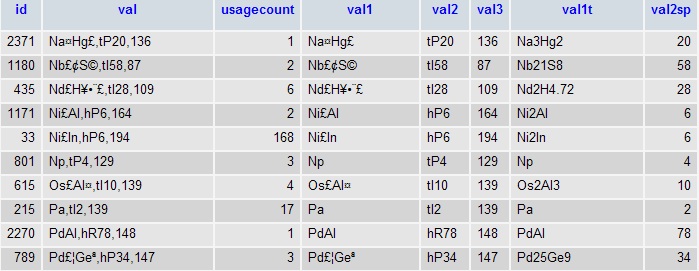
We still have some work to do. Let’s take the two structures Ni2Al and Ni2In. Say that we are looking for superstructures, which have the property that the "atoms occupy atomic positions according to the parent crystal structure". The AET for Ni2Al is given as 14-b;14-b;14-b; whereas the AET for Ni2In is given as 11-a;11-a;14-b; . We want every atom to have the parent crystal structure (14-b – the rhombic dodecahedron for bcc), so we will eliminate those ones that have other AET.
mysql_query("USE pauling");
$ids_q = mysql_query("SELECT id FROM s07pt.bcc");
while($ids = mysql_fetch_row($ids_q))
{
$id= $ids[0];
$query = "
SELECT COUNT(DISTINCT val) FROM pauling.val032
INNER JOIN
(
SELECT v AS EntryCode FROM
(
SELECT pauling.val001.val AS v FROM pauling.val001
INNER JOIN paulingv2.val032
USING (EntryCode)
WHERE paulingv2.val032.val = ".$id."
) AS A
INNER JOIN
(
SELECT pauling.val001.val AS v FROM pauling.val001
INNER JOIN paulingv2.val086
USING (EntryCode)
WHERE paulingv2.val086.val != 6
) AS B
USING (v)
) as C USING (EntryCode)";
$query = mysql_query($query);
$result = mysql_fetch_row($query);
$result = mysql_result($query,0);
$result = ($result+1)%2;
$query = "UPDATE s07pt.bcc SET incl_theo = $result where id = $id LIMIT 1";
$j++;
echo $j.".\t".$query."\n";
mysql_query($query);
}
"incl_theo" is the column which is equal to 1 if the structure in question contains no AET other than 14-b, 0 otherwise. This gives us smt. like:
